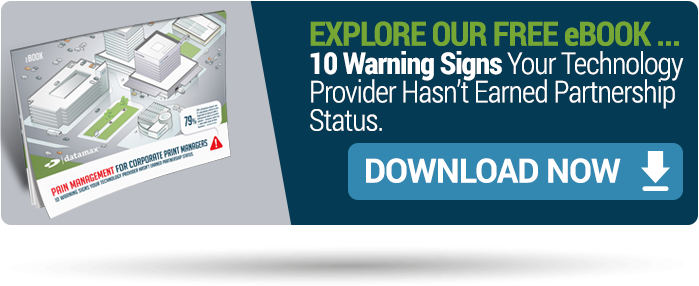
“Our fleet, our workflows, and our costs are a cluster.” – Mary B., Office Administrator.
There’s a certain chemistry involved with investigating print environments and the ways in which they interact, merge, and change over time.
Chemical synthesis is the purposeful execution of combining and manipulating multiple molecules to create one unique compound that is both unified and reliable. Much like the molecules that change through chemical reactions, major accounts are constantly affected by real world changes within and outside of your organization:
- Selling a division of your company,
- Adding a department,
- Your stocks take a hit,
- Company relocation,
- Company acquisition,
- Disaster Recovery,
- Outsourcing print or bringing it in-house
Your printing needs evolve accordingly.
This leaves a fleet administrator in the difficult position of trying to both optimize a budget and maintain control over cost.
Right-sizing your fleet (right device mix, right location, right application, right volume) is a key component to any partnership commitment. It’s a fluid process of not only right-sizing, but synthesizing fleets: Combining the scattered and constantly changing elements of your workflow into one coherent, cost-effective whole.
Let’s take a closer look at a well-conceived Right-Sizing Fleet Methodology that might be beneficial for your organization.
Step 1: Define the Problem
Every organization has its unique way - consciously or unconsciously - of configuring its fleet, printing and handling documents, and utilizing fleet technology, but few confidently know if each is optimized. Defining problem areas, aka trying to figure out how to improve operational efficiencies, is the first substantial process in assessing and eventually optimizing your fleet performance.
Step 2: Make the Observation
A trusted technology partner will observe your current print trends carefully and thoroughly. Through a holistic print and workflow assessment, a consultative team can help you identify opportunities for streamlining print processes, maximizing productivity of print assets and people, and improving total cost of ownership.
An ALL Associates Group study states that “hard, visible costs are only about 10% of the total document cost.” Your technology partner can look microscopically at devices across your print landscape, detect hidden costs and develop a plan for more cost-effective measures.
Step 3: Form a Hypothesis
Gathered from the assessment observations, a “Hypothesis” is essentially a developed print strategy. It's a process of assessing data and findings and synthesizing them to develop a cohesive picture: What should encompass your fleet of devices, how can they be best utilized, and what sort of rules-based-printing can you administer to reduce wasteful practices?
Step 4: Analyze the Data
Right-sizing in many ways is a simple function of optimizing workflow. Not just today but throughout our entire partnership journey. A number of machine-embedded diagnostic tools can analyze monthly device metrics (overall volume, color usage, etc.) by department and by device, identifying inefficiencies and where waste is currently being amassed.
In the journey beyond your purchase or lease, your business is undoubtedly affected by structural and economic changes. Leveraging a Right-sizing approach allows you the ability to “downsize” your MFP fleet with flexibility and without hidden charges.
Likewise, you have ability to “upsize” or add additional device units should be subject to initial discount levels when possible. After all, the big picture of your account should always remain in focus.
Finally, if your partner is really helping you manage your print fleet and output, you should not be penalized for device relocation moves that occur within your account’s building or adjacent campus when possible.
Step 5: Communicate the Results
It’s vital to communicate the results of our findings.
A regularly-scheduled Partnership Review is an opportunity to formally reassess the current state of your fleet and communicate with you possible next steps. At these meetings, discussions take place on overall performance statistics, overall cost analysis as well as current fleet utilization.
You will also plan for the future: Are there facility/location changes? Any assistance in better tracking print output from your devices? Can communications or response be enhanced in any ways?
Step 6: Synthesize Your Fleet
Throughout a partnership journey together, a commitment to continually investigate the moving parts of your fleet should be relentless.
Between utilizing the right BW/color ratio, strategically adding or removing devices, device relocation, and continually analyzing data and communicating best steps moving forward, your fleet will be better synthesized.
At Datamax, our print-mission is to combine the collected workflow-associated elements into one coherent, cost-effective whole. Click below to set up a meeting and learn more and consider ways we can help right-size your fleet.
Are you ready to synthesize your print environment? If you are interested in learning more about the true value of partnership as it relates to managing your fleet, schedule a meeting with one of our Datamax Key Account Program Consultants!
Cleayton Mills is the Vice President of Sales at Datamax Texas and the Head of the Datamax Key Account Program (DKAP). He can be reached at (800) 633-1526.


